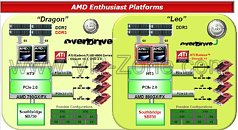Tuesday, September 1st 2009

AMD Preparing ''Thuban'' Desktop Six-Core Processor
AMD is planning to create a desktop implementation of its Opteron "Istanbul" monolithic six-core processor. Codenamed "Thuban" (named after a star in the Draco constellation, which means Dragon), the new processor will be based on the socket AM3 package for compatibility with existing and future desktop core logic. It features six cores, 9 MB of total cache (6 x 512 KB L2 + 6 MB L3). Thuban is aimed to make for AMD's high-end desktop processor, as the company prepares to face competition from a near-complete lineup of processors based on the Nehalem/Westmere architectures from Intel. It is expected to be the posterboy for AMD's "Leo" high-end consumer desktop platform that succeeds its current Dragon platform.
Some of the key components that make up AMD Leo platform are the upcoming AMD 890FX and 890GX chipset, companion SB800 series southbridge chips, and members of AMD's Evergreen family of DirectX 11 compliant graphics processors. On the software front, AMD will give its Fusion and Overdrive utilities some big updates. The SB800 series southbridge chips will feature native support for SATA 6 Gb/s and USB 3.0; connectivity is further enhanced by integrated Broadcom MAC Ethernet interfaces. While the Leo platform is expected to launch almost simultaneously with the 8-series chipsets, the six-core Thuban processor on the other hand comes later. It is due only in Q3 2010. Thuban will have come out an year after its enterprise implementation in the form of Opteron "Istanbul".
Sources:
X-bit Labs, VR-Zone
Some of the key components that make up AMD Leo platform are the upcoming AMD 890FX and 890GX chipset, companion SB800 series southbridge chips, and members of AMD's Evergreen family of DirectX 11 compliant graphics processors. On the software front, AMD will give its Fusion and Overdrive utilities some big updates. The SB800 series southbridge chips will feature native support for SATA 6 Gb/s and USB 3.0; connectivity is further enhanced by integrated Broadcom MAC Ethernet interfaces. While the Leo platform is expected to launch almost simultaneously with the 8-series chipsets, the six-core Thuban processor on the other hand comes later. It is due only in Q3 2010. Thuban will have come out an year after its enterprise implementation in the form of Opteron "Istanbul".


93 Comments on AMD Preparing ''Thuban'' Desktop Six-Core Processor
And no. L2 cache is "full-speed" meaning it runs at CPU clock speed. Not "HT link speed". HT link actual clock-speed == NB clock speed.
Now, let's bring this up to today's processors with L3, which as you have already stated run at the speed of the Northbridge. My Northbridge runs at 2.3ghz...this means that my L3 Cache only runs at 2.3Ghz. My Core Speeds are at 3.6Ghz, which means that my L2 Caches are also running at 3.6Ghz which i considerably faster. So...as I have said, having more of a faster L2 Cache would be a bit better.
I am not saying that Cache is going to make all the difference in the world, there are many other factors that are involved with a good processor...but every little bit helps. 5% may not seem like a lot, but when you are looking to squeeze every little ounce of power out of your processor....5% helps a lot.
What is the ETA on the 6-core Nehalems, currently ? That thing is my next chip, unless I lose my job until then...
I will give you this much. At higher overclocks (approaching 4Ghz), the L3 cache doesn't make as much of a difference in such tasks as Video Encoding, raring and unraring, etc. But when it comes to Gaming performance, it seems to make a rather good size difference. 10fps may not seem like a big deal...but it could be the difference in a playable game and a paperweight in a box.
Now if you will notice at my first suggestion...it was to bump up the L2 a little. not the L3.
I'll conclude saying that more cache isn't going to help AMD's cause. It doesn't provide the kind of performance that makes upping transistor counts by 100s of millions of transistors worth it, or feasible. As it stands, AMD Deneb has 758M transistors vs. a lesser transistor count of 731M on Intel Bloomfield, and Bloomfield emerges the superior core. Development is due on different fronts than cache.
I went thru 4 brisbanes, all of them were ass compared to my F3 Windsors.
As for increasing L2: The Core 2 Quads have insane L2 cache sizes of up to 12Mb, while the i7 only has a small 4x256Kb L2 cache (And of course, the 8Mb L3 cache). The Phenom II X4 has 4x512Kb of L2 cache (And the 6Mb L3). Out of the three architectures, the i7 seems to be the best one. Based on this, I highly doubt that increasing the L2 cache on the Phenom IIs is really going to do very much, except for making the CPU more power-demanding and more expensive.
AMD isn't in the position of making their products more expensive, especially if it offers no real gain.